
Hi Archinect!
6:25: I have springtime allergies here and would rather be at home...but here I am...live blogging Rosalind Williams' keynote lecture for this weekend's Landscape Infrastructure conference.
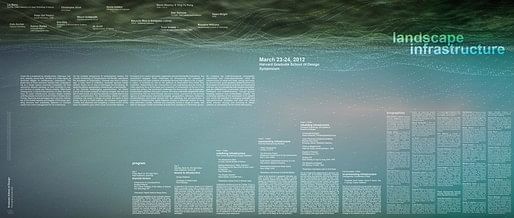
The conference, organized by GSD Landscape professor Pierre Bélanger, is subtitled "Systems & Strategies for Contemporary Urbanization" and the official description reads:
A two-day symposium exploring the future of infrastructure and urbanization beyond the dogma of civil engineering and transportation planning. Presentations and panel discussions focus on the growing agency of ecology to propose responsive strategies that address the predominant challenges facing urban economies today including climate dynamics, carbon and nitrogen accumulation, population mobilities, and resource economies.
6:33: All right, we're in half Piper and there are no less than two and a half rows saved for VIPs. It's crowded and students are hanging off the balconies.
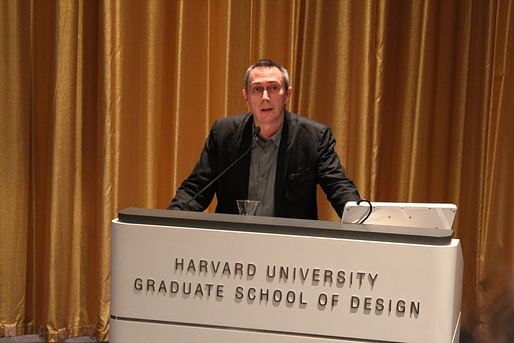
6:40: (Right on GSD time!) Charles Waldheim kicks things off. Pierre Bélanger started his work on infrastructure while at the University of Toronto and CW is glad that we've been able to nab (OK, so he doesn't use the word "nab") him for the GSD.
Infrastructure is a central topic and one that is nested with the interests of landscape urbanism; it also has been important in the foundation of Landscape Architecture as a discipline as well as in the development of the Landscape Architecture department and program at the GSD.
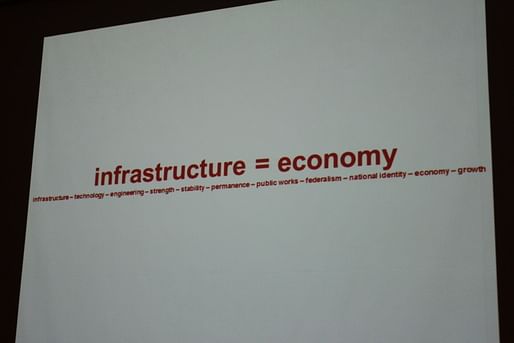
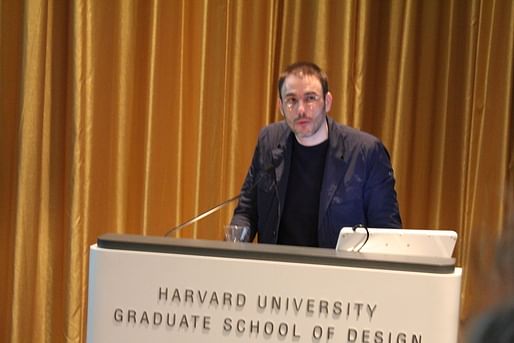 6:45: Pierre Bélanger. Infrastructure is "the glue of urbanization." We're going to talk about it "beyond the dogma of civil engineering and urban planning." Civil engineering spends trillions of dollars of federal funding in the United States.
6:45: Pierre Bélanger. Infrastructure is "the glue of urbanization." We're going to talk about it "beyond the dogma of civil engineering and urban planning." Civil engineering spends trillions of dollars of federal funding in the United States.
It's important to understand the supremacy of civil engineering and of (technocratic) thought in this area. Civil engineers and construction managers are the true master builders of the 20th century. We don't have a problem of a lack of technology, but we do have a problem of reciprocity between technology and ecology.
Central to the position of landscape practice is the notion of multiple scales. Paul Edwards, media theorist and communications historian, who says that:

PB refers to the founding of Harvard's Landscape Architecture program in 1900 and to MIT's short-lived program from 1900 to 1909, which recruited women (at a time when Harvard's program did not).
Mention of Sigfried Giedion and (western Canadian...woot woot) Christopher Tunnard:

6:56: I sneeze.
6:57: Introducing Rosalind Williams with this quote from her:

7:00: "Yet for all the physical proximity to the fields of engineering, technology, and science, [Williams] has retained a humanistic position..." Her lecture comes at an important time of convergence of design and technological disciplines.
Recap of Williams' books. Notes on the Underground talks about those underground spaces that have everything that modern civil engineers should love: facade-less buildings, pipes, fluids, etc. Retooling: a Historian confronts Technological Change is a history of MIT's role in the technology of this century and the last.
 7:05: Rosalind Williams. She'll be talking mostly about Robert Louis Stevenson, but is starting with a few comments on infrastructure.
7:05: Rosalind Williams. She'll be talking mostly about Robert Louis Stevenson, but is starting with a few comments on infrastructure.
Infrastructure, like technology, turns out to be a recent term and promiscuous term. These words are taking on new meanings in the the face of the changes these words are supposed to describe, as Raymond Williams observes in Culture and Society.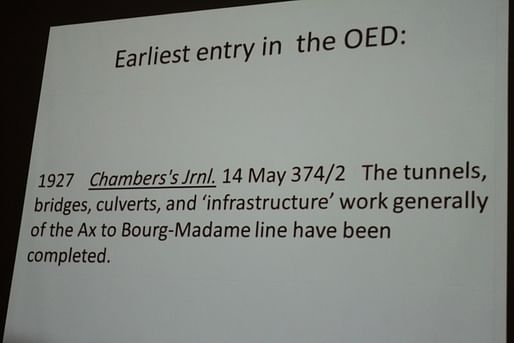
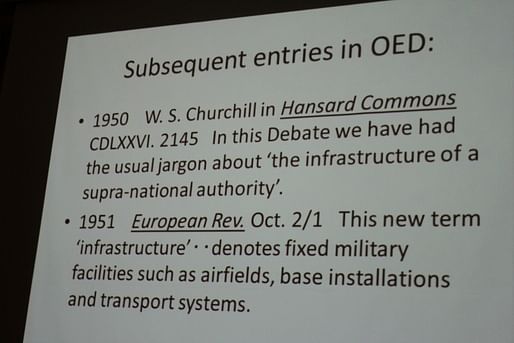


We love railroads! They are visible as infrastructure. As Alfred D. Chandler writes in The Visible Hand, the railroad is the pioneer of modern business administration.
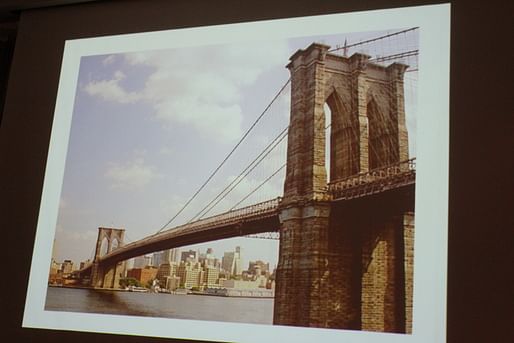
Chandler's student, Thomas Hughes, in Networks of Power, studied electricity as a system in a similar way.
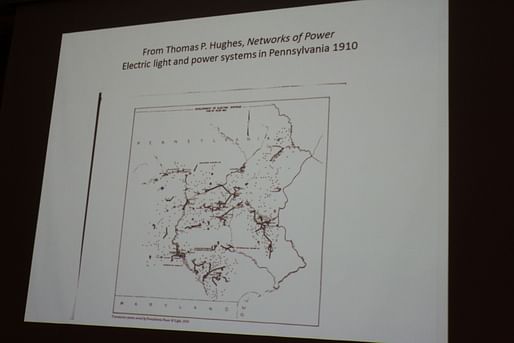
And then Paul Edwards talks about infrastructure as "cyber infrastructure."

 7:17: On to Robert Louis Stevenson. He lived a short life during the "second industrial revolution."
7:17: On to Robert Louis Stevenson. He lived a short life during the "second industrial revolution."
The Stevenson family was in the lighthouse business. There is a fundamental tension between the engineers' desire to build lighthouses and the highlander people's suspicion of them. At first glance, what could be wrong with a lighthouse, as it saves lives by preventing wrecks? But for highlanders, who retrieved goods from shipwrecks, the wrecks provided a source of income. For them, this infrastructure was unwanted.
 In his writing, RLS compares writing to the beacon that lighthouses are supposed to provide. It's meant to provide peace, love, and hope, but can also be experienced as an invasion.
In his writing, RLS compares writing to the beacon that lighthouses are supposed to provide. It's meant to provide peace, love, and hope, but can also be experienced as an invasion.

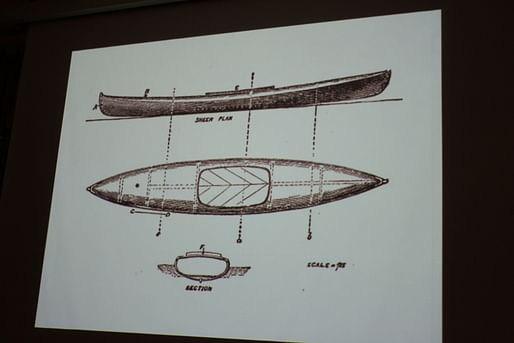 7:28: RLS publishes his first book, called An Inland Voyage, in 1878. It's about two boys paddling a "canoe" (more like a kayak) along the Seine. They are using the infrastructure of these waterways for an unintended purpose.
7:28: RLS publishes his first book, called An Inland Voyage, in 1878. It's about two boys paddling a "canoe" (more like a kayak) along the Seine. They are using the infrastructure of these waterways for an unintended purpose.
7:31: RLS met a woman (Fanny) and they became lovers; after receiving a letter from her he went to go see her in San Fransisco from the UK. The voyage took three weeks and he kept a "sordid" diary of his experience that "out Zola-ed Zola." He took an immigrant ship across the Atlantic: "for ten days we were in one small iron country on the deep."
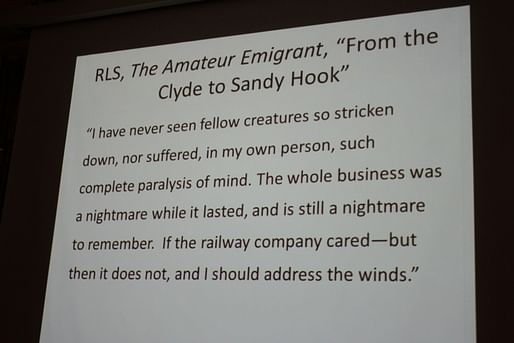
 He didn't like the railway either, and almost died on the cross-country trip. He couldn't sit down or sleep, and could hardly get off at stations to buy food. He could also hear what the other people were talking about, and noted that they were talking about all the opportunity they hoped to find. Yet he noticed that, coming the other way, were more train cars carrying Asians coming east; they, too, were crossing the continent in hopes of finding a more prosperous future.
He didn't like the railway either, and almost died on the cross-country trip. He couldn't sit down or sleep, and could hardly get off at stations to buy food. He could also hear what the other people were talking about, and noted that they were talking about all the opportunity they hoped to find. Yet he noticed that, coming the other way, were more train cars carrying Asians coming east; they, too, were crossing the continent in hopes of finding a more prosperous future.
He lived with Fanny, and it was a very cold place, so when a publisher offered that he could live on a yacht in the South Seas and publish a book by writing letters from it, he agreed!
So we have seen RLS' use of infrastructure in terms of "agency of the user" (on his canoe), in terms of "the tragedy of mobility" (in being crowded on the ship and train), and now we will see "infrastructure as conquest."

 RLS lived in Hawaii and saw the destruction of the Polynesians at the hands of the "vile" white western Europeans, and increasingly sided with the Polynesians.
RLS lived in Hawaii and saw the destruction of the Polynesians at the hands of the "vile" white western Europeans, and increasingly sided with the Polynesians.
7:42: RLS decided to stay and live in Samoa. There was regular post service there, and he could write his books from there and send them in. He did great writing there, RW recommends one called The Ebb Tide.
A series of Samoan wars from 1892-3. A chieftan was imprisoned by the Germans, and the other chieftans went with them. RLS supported them during the imprisonment, and when the chieftan was allowed to go into exile, they decided to show their gratitude to him by building a road to his house. They called him by a name that could be translated as the "Storyteller," or perhaps "Chief Information Officer."
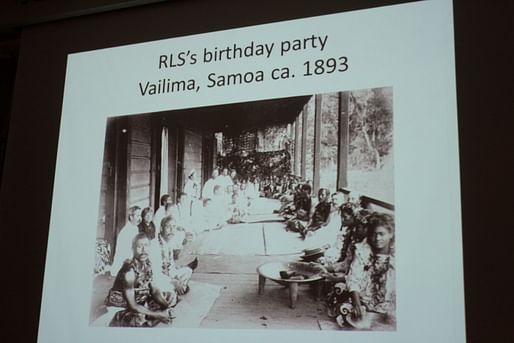
 At first, RLS didn't want to accept the gift, but then he decided to accept it because of the lesson it taught. He said that the only way that Samoa would be saved would be for them to inhabit it, to pick its crops and sell them. If they don't occupy their own land, then westerners would come and do it for them. That is, he promotes infrastructure that supports inhabitation, not mobility.
At first, RLS didn't want to accept the gift, but then he decided to accept it because of the lesson it taught. He said that the only way that Samoa would be saved would be for them to inhabit it, to pick its crops and sell them. If they don't occupy their own land, then westerners would come and do it for them. That is, he promotes infrastructure that supports inhabitation, not mobility.
Lessons of the road:
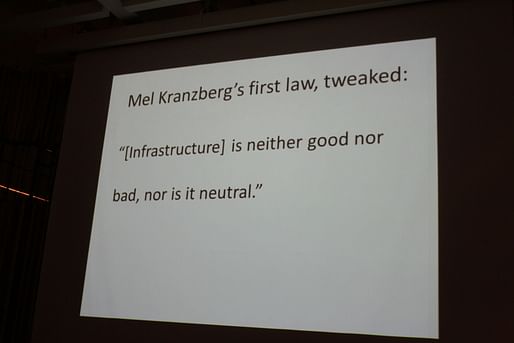
Today is the 100th anniversary of the opening of the Red Line from Park Street to Harvard Square. A brochure from that day, one hundred years ago, reads: "to save time is to lengthen life."
Fifty years ago, construction began on Exit 17 of the Mass Pike, on the land where RW's grandparents lived.
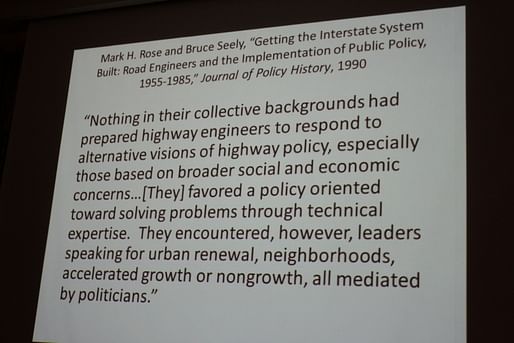
Much of the conversation tomorrow is about engineers and designers working together. Interdisciplinarity is difficult, but necessary. RW shows the current mission statement of MIT's Department of Civil and Environmental Engineering:
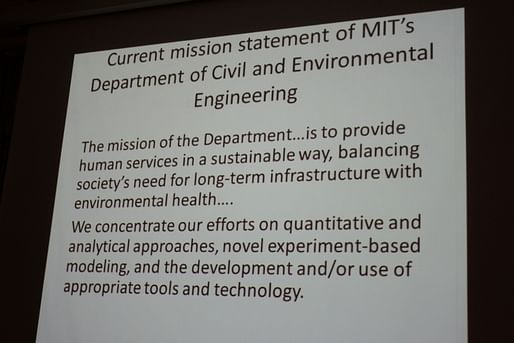

The last sentence tells us that although they seek interdisciplinary collaborations, they will not "use their slots" to hire these people for their own departments. That is, there are limits to how far departments are willing to go in terms of interdisciplinarity.
The question of power: who is paying for projects? Who is in charge?
The lack of public support for infrastructure spending today. "It's not unlike the broken windows syndrome, not locally but nationally."
7:57: Pierre Bélanger introduces the respondents who will fill out the panel: Rania Ghosn and Hashim Sarkis. [It is very stuffy and crowded in here, and when I can't breathe, I can't type, so my comments will be brief from here on. People are trying to get out but it's so crowded on the stairs that even this is difficult.]
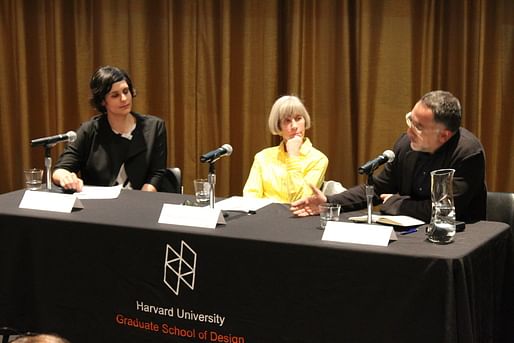
Hashim Sarkis comments on Jack Kerouac and Kevin Lynch, two other "road characters."
Rania Ghosn comments.
Rosalind Williams: It's hard for students when you tell them not to use the word "technology" unless they say what they mean by that word. Because students are so used to it (as their go-to word).
etc.
Thanks for reading!
Lian
P.S. You can watch the event at the GSD's YouTube Channel.
This blog was most active from 2009-2013. Writing about my experiences and life at Harvard GSD started out as a way for me to process my experiences as an M.Arch.I student, and evolved into a record of the intellectual and cultural life of the Cambridge architecture (and to a lesser extent, design/technology) community, through live-blogs. These days, I work as a data storyteller (and blogger at Littldata.com) in San Francisco, and still post here once in a while.



6 Comments
Lian, hope you feel better soon! Thanks for providing the commentary. Fascinating line up - but will anybody say anything deeper then the current hagiography of infrastructure. Though I'm wondering if now that the GSD has scribbled all over the topic, is infrastructure now officially closed as a topic for scholarship?
Thanks, Barry! I'd be surprised and disappointed if infrastructure were "over" as a topic, but I guess we will see....
Love these live blog posts! Great job!!!
I'm hoping there will still space for me to give my own spin to infrastructure with an eventual book, but when the GSD takes on a topic, the oxygen usually gets sucked out of the room for a few years.
@PradaTransformer: thanks, I appreciate it!
@Barry: I hope you can, too! What topics have you noticed this effect with in the past?
so - talk of Boston's hwy infrastructure and no mention of the southwest corridor?
Block this user
Are you sure you want to block this user and hide all related comments throughout the site?
Archinect
This is your first comment on Archinect. Your comment will be visible once approved.